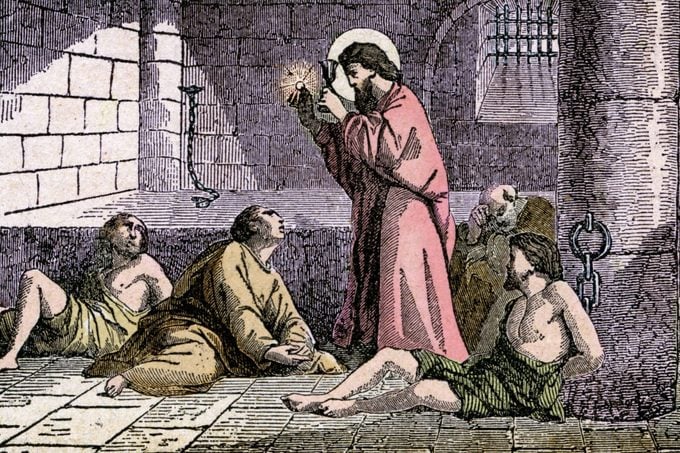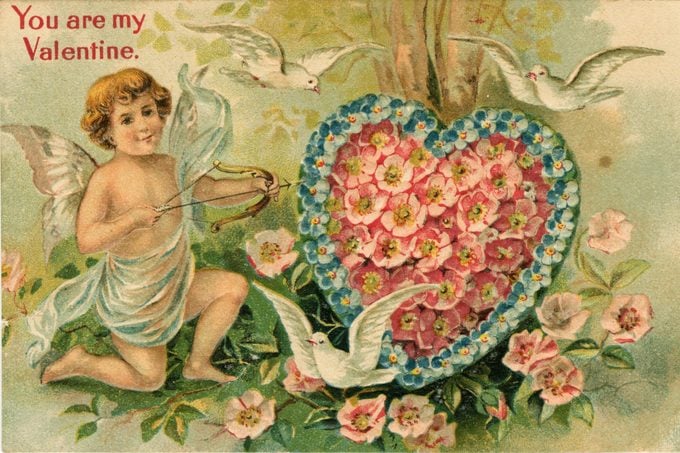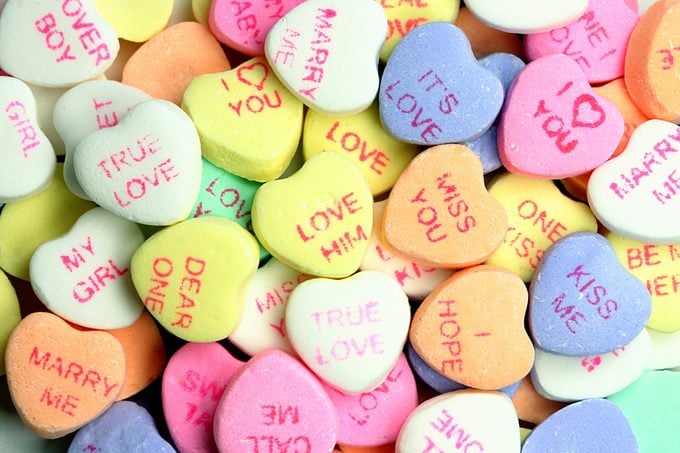What and when is Valentine's Day? Well, the unromantic history of Valentine's Day may surprise you.

What Is Valentine’s Day, and Why Do We Celebrate It?

Some of us love love, thrilling at the prospect of spending a whole day celebrating it with flowers, Valentine’s Day cards, gifts, or going on a date at a romantic restaurant. Others feel like the popular version of love has been commercialized and confused. But regardless of how you feel about Valentine’s Day, the “holiday of love” is one of the most popular traditions in Western culture. Throughout the history of Valentine’s Day, people have used the holiday as an excuse to celebrate romantic love and passion. These days, it’s also a time to celebrate platonic love, with everyone from elementary-aged children to the elderly sharing valentines with them or to brighten up a friend’s day by simply sending them a Galentine’s Day quote. But what is Valentine’s Day, exactly?
This holiday didn’t just magically appear out of nowhere, and contrary to popular belief, it wasn’t invented by greeting card companies. Valentine’s Day has a rich (and slightly morbid) history that you may not know about. Read on to learn about the history of Valentine’s Day, how the holiday is celebrated (with some fascinating Valentine’s Day trivia) and who the heck St. Valentine really was. (Spoiler: It wasn’t just one person!)
While you’re at it, discover how to celebrate Valentine’s Day, according to your zodiac signs!
Get Reader’s Digest’s Read Up newsletter for more insight on holidays, humor, cleaning, travel, tech and fun facts all week long.
What is Valentine’s Day?

Valentine’s Day is an annual holiday celebrated in the United States and many other countries around the world. Historically, it has commemorated romantic love, but recently, it’s been expanded to include all types of love. Just look at Galentine’s Day, which celebrates female friendships.
When is Valentine’s Day?
This holiday always occurs on the 14th day of the month of February, but the day of the week rotates. Below, you’ll learn which day of the week to expect the holiday for the next five years (you know, in case you want to make those Valentine’s Day restaurant reservations now).
- Friday, Feb. 14, 2025
- Saturday, Feb. 14, 2026
- Sunday, Feb. 14, 2027
- Monday, Feb. 14, 2028
Is Valentine’s Day an official holiday?
Valentine’s Day was never named an official national holiday in the United States, but it continues to be a popular holiday in the country.
How did Valentine’s Day start?
Answering “What is Valentine’s Day?” is simple, but the history of the holiday is a bit more complex. Like many modern holidays that have been celebrated for centuries, Valentine’s Day has its roots in paganism. Lupercalia was a pagan fertility festival typically celebrated in February. Like the Valentine Cupid, it had ties to a Roman god. The festival was dedicated to Faunus, the Roman god of agriculture, and to Romulus and Remus, the Roman founders.
Lupercalia was all about fertility, but not in the modern sense of love and romance. Priests from an order called Luperci sacrificed a goat and dog, skinned them, soaked their hides in blood and then used them to gently “whip” young women, a tradition aimed at making the women more fertile. After that, the women’s names were put in a jar, and each eligible young man drew a name, forming a couple for the next year (and possibly leading to marriage if it worked out).
Who is Valentine’s Day named for?

Valentine’s Day is named for St. Valentine. But it gets more complicated from here. As it turns out, at least three Valentines were sainted by the Catholic Church, and each one has his own group of supporters claiming he’s behind the holiday.
Who were the Valentines sainted by the church?
The first St. Valentine was a rebel, defying a decree from the Roman Emperor Claudius II, which said young men were not allowed to be married and had to serve in the military instead. (The Romans believed single men made better soldiers.) St. Valentine continued to marry lovers in secret.
The second St. Valentine helped Christian prisoners escape Roman jails—until he was caught and imprisoned himself. His last act before death was to miraculously heal the daughter of his jailer, thereby converting the whole family to Christianity. In some versions of the story, St. Valentine II was even in love with the daughter, but their love was tragically cut short.
The third St. Valentine was a Catholic bishop in Terni. History hasn’t remembered much about him, and the stories of all three saints have become entwined over the centuries. The story became so murky and confusing that, in 1969, the Catholic Church removed the St. Valentine’s feast day from the Christian liturgical calendar.
But there was one unfortunate thing all three men had in common besides their name, and it’ll give you pause before uttering your next “Happy Valentine’s Day.” In a very unromantic twist, all three were martyred by beheading by different Roman emperors. In some versions of the stories, the men were all executed on or near Feb. 14 (in different years), but historians have been unable to verify that detail.
Why is Valentine’s Day on Feb. 14?

The holiday is on Feb. 14 because Christians wanted the church to be separate from Lupercalia. In an effort to clean up the pagan holiday, Pope Gelasius I integrated Lupercalia with St. Valentine’s Day in the fifth century. The new holiday quickly spread to all the countries that practiced Christianity. Chaucer and Shakespeare also played a part in the history of Valentine’s Day by changing the holiday from a bloody sex festival to a modern love story by writing about it in a sweet, lighthearted and decidedly less-lascivious way.
Christian settlers brought the holiday with them to the New World, where it became one of the most popular holidays during the Victorian era. In the 1900s, people began giving one another Valentine’s Day cards—and Hallmark began offering them in 1913. The tradition grew from there, and today Hallmark estimates 145 million Valentine’s Day cards are exchanged each year.
What are some popular Valentine’s Day traditions?
Valentine’s Day is filled with fun traditions, including decorating with paper hearts, trying heart-shaped food recipes, coloring everything red and pink, and giving Valentine’s Day gifts for him and Valentine’s Day gifts for her.
Watching a romantic movie
There’s a timeless allure to snuggling up with a loved one to watch romantic movies on Valentine’s Day. Plus, it’s more than just a trend—it’s a heartfelt tradition that, even for a moment, can make you believe in the power of love. Whether it’s classic rom-coms (like When Harry Met Sally…) or more tragic love tales (like the Titanic), watching romantic films can bring you closer together, even after the credits roll.
Eating candy conversation hearts

Heart-shaped and printed with short sayings, these chalky (but still weirdly delicious) sweets are unique to Valentine’s Day. But where did they come from?
Candy hearts originated in the late 1800s with a Boston pharmacist who made Necco wafers as “lozenges.” His brother got the brilliant idea to print sayings on them for many occasions, but it was the messages of love that really took off. One of the first Valentine’s messages was “How long shall I have to wait? Please be considerate.” How … romantic?
By the 1910s, they were a fixture of the holiday. Eventually, Brach’s made them smaller, shaped them into hearts and added the candy heart sayings we all know and love today.
Giving valentines
According to the lore, the second St. Valentine didn’t just fall in love with his jailer’s daughter. He also sent her a final farewell letter, signed “from your Valentine.” Romantic Victorians ran with this phrase, signing it on elaborate Valentine’s Day cards professing their love during the holiday. In 1913, when Hallmark began mass-producing official valentines, it cemented the tradition, which continues to this day.
Sending bouquets of red roses

Valentine’s Day flowers universally symbolize romantic love, and these days, a bouquet of red roses is one of the most popular gifts to give a loved one on Valentine’s Day. But why? Well, it helps to understand the meaning behind rose colors.
Red has long represented love and passion, perhaps because it is the color of the blood being pumped through the heart. The rose comes from Roman mythology—the red rose (symbolizing the blood of Adonis, the god of love) was dedicated specifically to Venus, the goddess of love. Similarly, white roses symbolize purity. Pink roses intertwine purity and romance, so many lovers choose bouquets with all three colors.
Giving a heart-shaped box of chocolates
This tradition, like much of the history of Valentine’s Day, has roots in the distant past. Several ancient cultures, including the Aztecs, considered chocolate an aphrodisiac. That, combined with the relative scarcity of sugar, made chocolate a popular gift to symbolize love and devotion.
Things took a turn for the commercial in the early 1900s, when Cadbury created a heart-shaped box for its chocolates. From there, it’s history!
Decorating with hearts
Hearts of the non-anatomical variety are the symbol of love, perhaps because the heart has long been considered the center of emotion and passion. When we’re in love, we often “feel” it in our chest. After a breakup, we experience heartbreak. In fact, we have a lot of words tied to a lot of emotions centered on our ticker: heartfelt, heartwarming, heart-wrenching and so on.
But why, exactly, does our symbol of love look so different from the shape of an actual human heart? A centuries-old anatomical misconception may be to blame. In describing a human heart, Aristotle noted “the heart has three cavities” and said “the rounded end of the heart is at the top. The pointed end is very largely fleshy and firm in texture.” Try to draw that, and you might end up with the sort of Valentine’s Day hearts we see plastered over everything in early February. But hey, they’re easy to draw and make a nice vehicle for funny Valentine’s Day quotes and silly V-Day puns.
Why trust us
At Reader’s Digest, we’re committed to producing high-quality content by writers with expertise and experience in their field in consultation with relevant, qualified experts. We rely on reputable primary sources, including government and professional organizations and academic institutions as well as our writers’ personal experience where appropriate. We verify all facts and data, back them with credible sourcing and revisit them over time to ensure they remain accurate and up to date. Read more about our team, our contributors and our editorial policies.
Sources:
- History.com: “History of Valentine’s Day”
- NPR: “The dark origins of Valentine’s Day”
- Hallmark: “Valentine’s Day”
- Statista: “Most popular national and religious events in the United States as of the 2nd quarter of 2023”
- History.com: “How Chocolate Became a Valentine’s Day Staple”
- Statista: “The Most Popular Valentine’s Day Gifts in the U.S.”
- Nature Medicine: “The shape of the heart”
- Spangler Candy: “History of Necco Wafers”























